Target Information
| Target General Information | Top | |||||
|---|---|---|---|---|---|---|
| Target ID |
T82262
(Former ID: TTDI03072)
|
|||||
| Target Name |
Calmodulin-dependent kinase II (CAMKK2)
|
|||||
| Synonyms |
KIAA0787; Calcium/calmodulin-dependent protein kinase kinase beta; Calcium/calmodulin-dependent protein kinase kinase 2; CaMKK beta; CaMKK 2; CaM-kinase kinase beta; CaM-kinase kinase 2; CaM-KK beta; CaM-KK 2; CAMKKB
Click to Show/Hide
|
|||||
| Gene Name |
CAMKK2
|
|||||
| Target Type |
Patented-recorded target
|
[1] | ||||
| Function |
Calcium/calmodulin-dependent protein kinase belonging to a proposed calcium-triggered signaling cascade involved in a number of cellular processes. Isoform 1, isoform 2 and isoform 3 phosphorylate CAMK1 and CAMK4. Isoform 3 phosphorylates CAMK1D. Isoform 4, isoform 5 and isoform 6 lacking part of the calmodulin-binding domain are inactive. Efficiently phosphorylates 5'-AMP-activated protein kinase (AMPK) trimer, including that consisting of PRKAA1, PRKAB1 and PRKAG1. This phosphorylation is stimulated in response to Ca(2+) signals (By similarity). Seems to be involved in hippocampal activation of CREB1 (By similarity). May play a role in neurite growth. Isoform 3 may promote neurite elongation, while isoform 1 may promoter neurite branching.
Click to Show/Hide
|
|||||
| BioChemical Class |
Kinase
|
|||||
| UniProt ID | ||||||
| EC Number |
EC 2.7.11.17
|
|||||
| Sequence |
MSSCVSSQPSSNRAAPQDELGGRGSSSSESQKPCEALRGLSSLSIHLGMESFIVVTECEP
GCAVDLGLARDRPLEADGQEVPLDTSGSQARPHLSGRKLSLQERSQGGLAAGGSLDMNGR CICPSLPYSPVSSPQSSPRLPRRPTVESHHVSITGMQDCVQLNQYTLKDEIGKGSYGVVK LAYNENDNTYYAMKVLSKKKLIRQAGFPRRPPPRGTRPAPGGCIQPRGPIEQVYQEIAIL KKLDHPNVVKLVEVLDDPNEDHLYMVFELVNQGPVMEVPTLKPLSEDQARFYFQDLIKGI EYLHYQKIIHRDIKPSNLLVGEDGHIKIADFGVSNEFKGSDALLSNTVGTPAFMAPESLS ETRKIFSGKALDVWAMGVTLYCFVFGQCPFMDERIMCLHSKIKSQALEFPDQPDIAEDLK DLITRMLDKNPESRIVVPEIKLHPWVTRHGAEPLPSEDENCTLVEVTEEEVENSVKHIPS LATVILVKTMIRKRSFGNPFEGSRREERSLSAPGNLLTKKPTRECESLSELKEARQRRQP PGHRPAPRGGGGSALVRGSPCVESCWAPAPGSPARMHPLRPEEAMEPE Click to Show/Hide
|
|||||
| 3D Structure | Click to Show 3D Structure of This Target | AlphaFold | ||||
| HIT2.0 ID | T73WJH | |||||
| Cell-based Target Expression Variations | Top | |||||
|---|---|---|---|---|---|---|
| Cell-based Target Expression Variations | ||||||
| Drug Binding Sites of Target | Top | |||||
|---|---|---|---|---|---|---|
| Ligand Name: Rosiglitazone + metformin | Ligand Info | |||||
| Structure Description | Structure of CaMKK2 in complex with CKI-012 | PDB:5YVC | ||||
| Method | X-ray diffraction | Resolution | 2.02 Å | Mutation | No | [4] |
| PDB Sequence |
VQLNQYTLKD
169 EIGKGSYGVV179 KLAYNENDNT189 YYAMKVLSKK199 PIEQVYQEIA238 ILKKLDHPNV 248 VKLVEVLDDP258 NEDHLYMVFE268 LVNQGPVMEV278 PTLKPLSEDQ288 ARFYFQDLIK 298 GIEYLHYQKI308 IHRDIKPSNL318 LVGEDGHIKI328 ADFGVSNEFK338 GSDALLSNTV 348 GTPAFMAPES358 LSETRKIFSG368 KALDVWAMGV378 TLYCFVFGQC388 PFMDERIMLH 399 SKIKSQALEF409 PDQPDIAEDL419 KDLITRMLDK429 NPESRIVVPE439 IKLHPWVTR |
|||||
|
|
||||||
| Ligand Name: CP-868596 | Ligand Info | |||||
| Structure Description | Crystal Structure of the Human CAMKK2B in complex with Crenolanib | PDB:6BQP | ||||
| Method | X-ray diffraction | Resolution | 1.95 Å | Mutation | No | [5] |
| PDB Sequence |
MQLNQYTLKD
169 EIGKGSYGVV179 KLAYNENDNT189 YYAMKVLSKK199 KLIRIEQVYQ235 EIAILKKLDH 245 PNVVKLVEVL255 DDPNEDHLYM265 VFELVNQGPV275 MEVPTLKPLS285 EDQARFYFQD 295 LIKGIEYLHY305 QKIIHRDIKP315 SNLLVGEDGH325 IKIADFGVSN335 EFKGSDALLS 345 NTVGTPAFMA355 PESLSETRKI365 FSGKALDVWA375 MGVTLYCFVF385 GQCPFMDERI 395 MCLHSKIKSQ405 ALEFPDQPDI415 AEDLKDLITR425 MLDKNPESRI435 VVPEIKLHPW 445 VTR
|
|||||
|
|
ILE171
3.593
GLY172
3.897
LYS173
3.780
GLY174
3.782
VAL179
3.444
ALA192
3.453
LYS194
4.047
VAL249
4.024
PHE267
3.479
GLU268
3.389
LEU269
3.609
|
|||||
| Click to View More Binding Site Information of This Target with Different Ligands | ||||||
| Different Human System Profiles of Target | Top |
|---|---|
|
Human Similarity Proteins
of target is determined by comparing the sequence similarity of all human proteins with the target based on BLAST. The similarity proteins for a target are defined as the proteins with E-value < 0.005 and outside the protein families of the target.
A target that has fewer human similarity proteins outside its family is commonly regarded to possess a greater capacity to avoid undesired interactions and thus increase the possibility of finding successful drugs
(Brief Bioinform, 21: 649-662, 2020).
Human Tissue Distribution
of target is determined from a proteomics study that quantified more than 12,000 genes across 32 normal human tissues. Tissue Specificity (TS) score was used to define the enrichment of target across tissues.
The distribution of targets among different tissues or organs need to be taken into consideration when assessing the target druggability, as it is generally accepted that the wider the target distribution, the greater the concern over potential adverse effects
(Nat Rev Drug Discov, 20: 64-81, 2021).
Human Pathway Affiliation
of target is determined by the life-essential pathways provided on KEGG database. The target-affiliated pathways were defined based on the following two criteria (a) the pathways of the studied target should be life-essential for both healthy individuals and patients, and (b) the studied target should occupy an upstream position in the pathways and therefore had the ability to regulate biological function.
Targets involved in a fewer pathways have greater likelihood to be successfully developed, while those associated with more human pathways increase the chance of undesirable interferences with other human processes
(Pharmacol Rev, 58: 259-279, 2006).
Biological Network Descriptors
of target is determined based on a human protein-protein interactions (PPI) network consisting of 9,309 proteins and 52,713 PPIs, which were with a high confidence score of ≥ 0.95 collected from STRING database.
The network properties of targets based on protein-protein interactions (PPIs) have been widely adopted for the assessment of target’s druggability. Proteins with high node degree tend to have a high impact on network function through multiple interactions, while proteins with high betweenness centrality are regarded to be central for communication in interaction networks and regulate the flow of signaling information
(Front Pharmacol, 9, 1245, 2018;
Curr Opin Struct Biol. 44:134-142, 2017).
Human Similarity Proteins
Human Tissue Distribution
Human Pathway Affiliation
Biological Network Descriptors
|
|
|
Note:
If a protein has TS (tissue specficity) scores at least in one tissue >= 2.5, this protein is called tissue-enriched (including tissue-enriched-but-not-specific and tissue-specific). In the plots, the vertical lines are at thresholds 2.5 and 4.
|
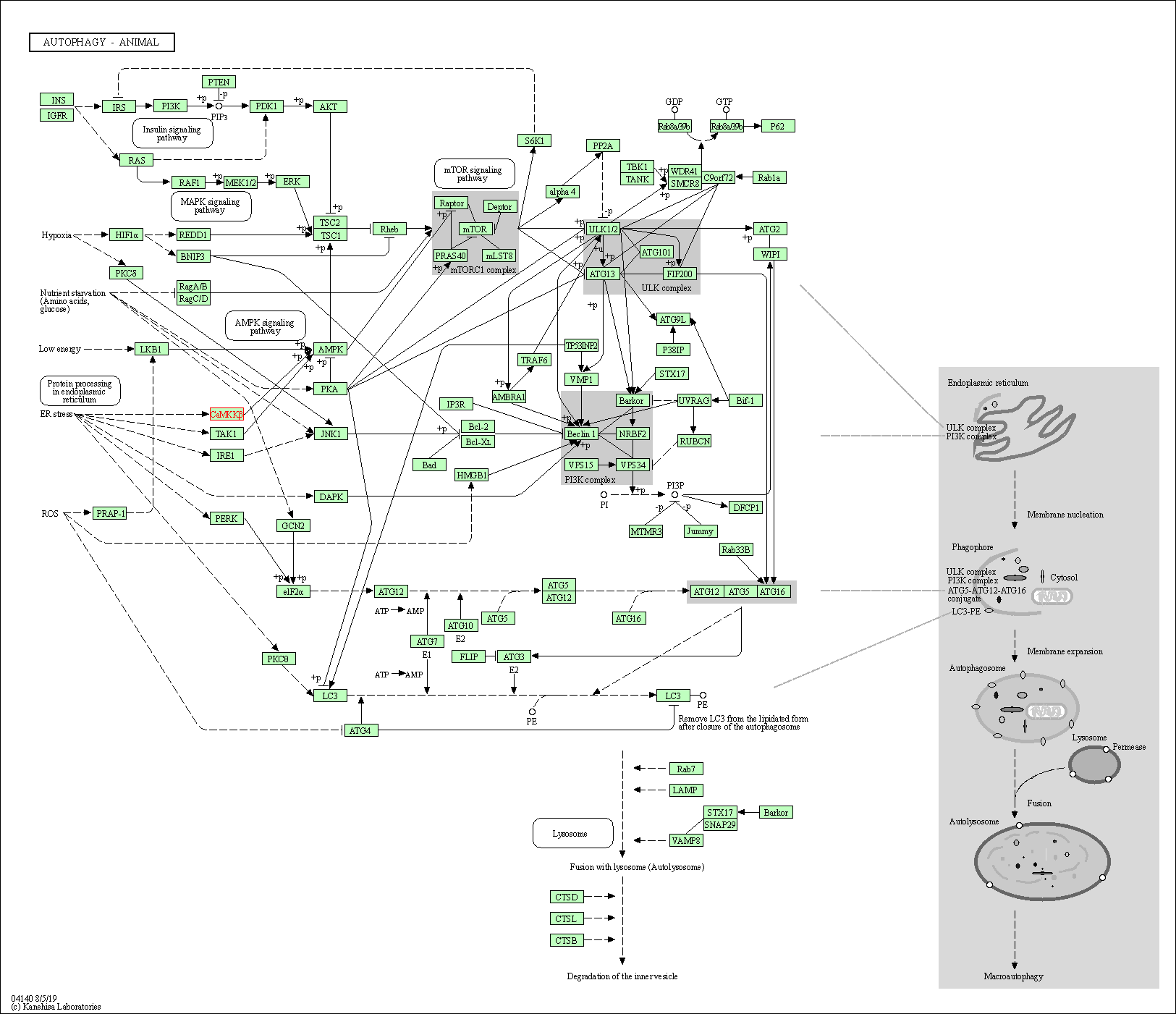
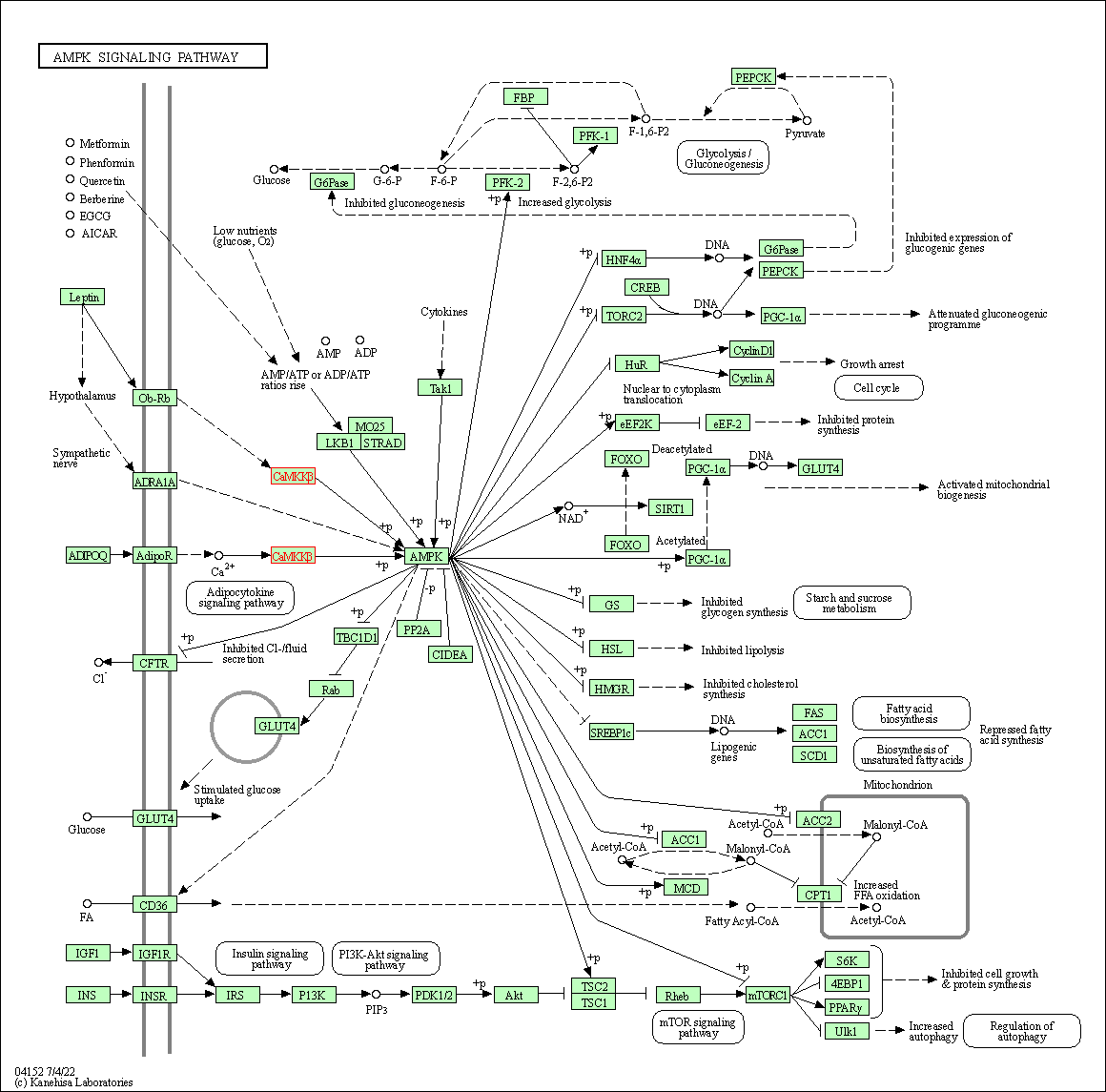
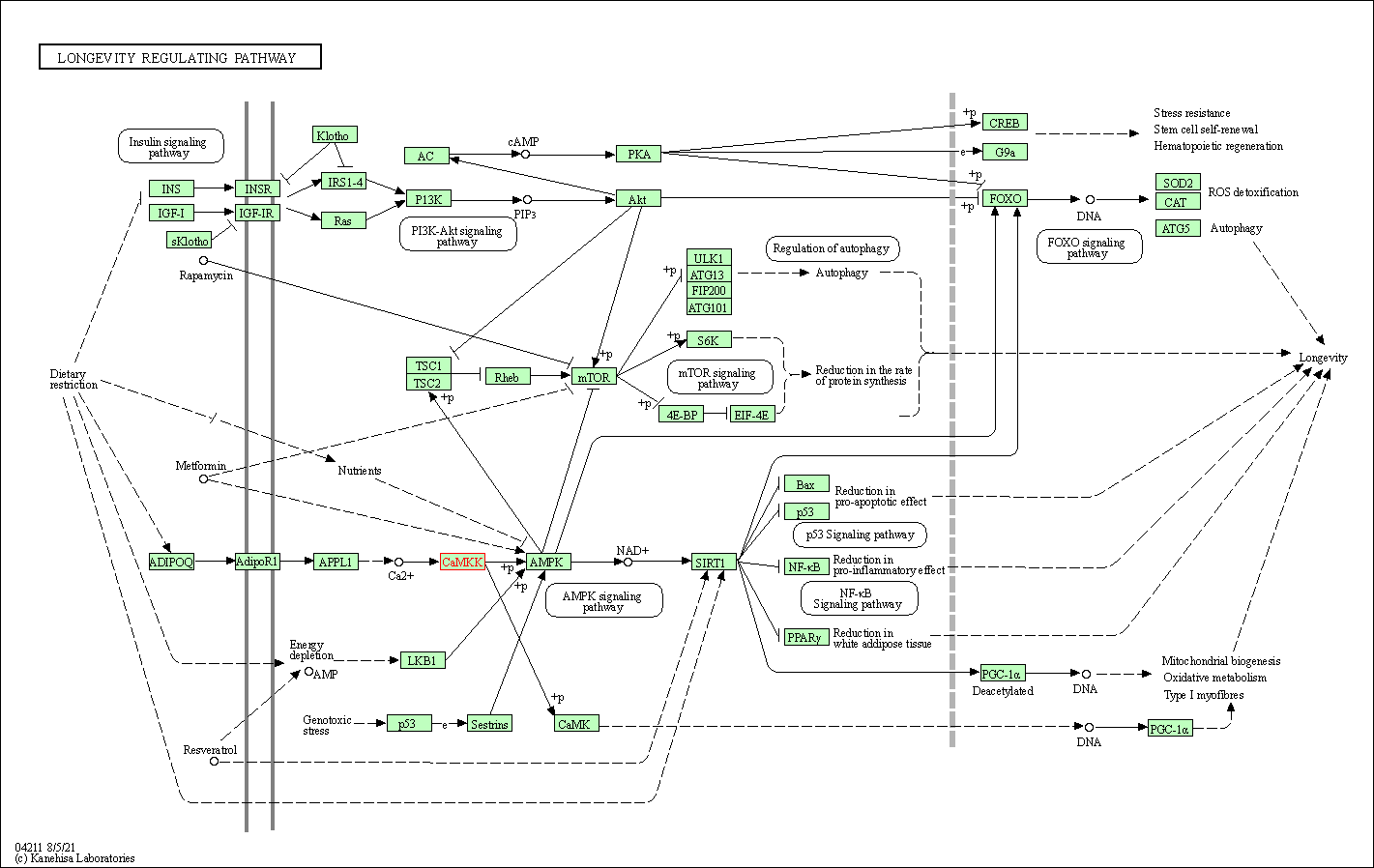
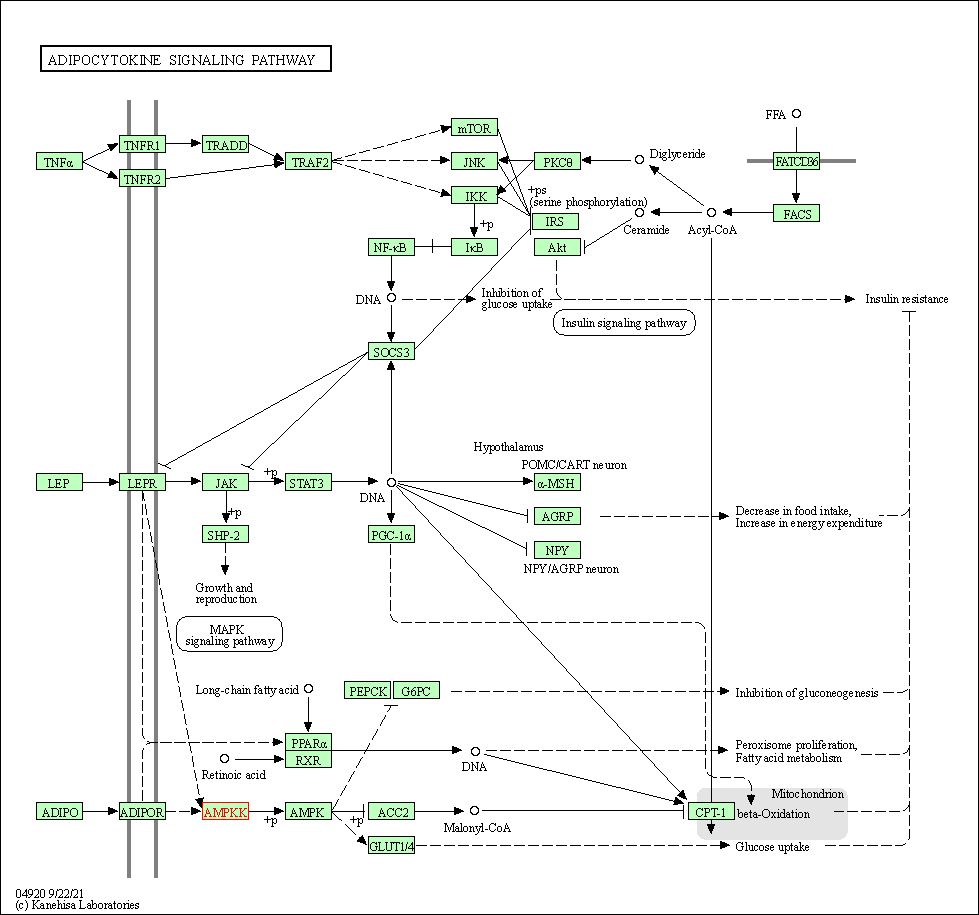
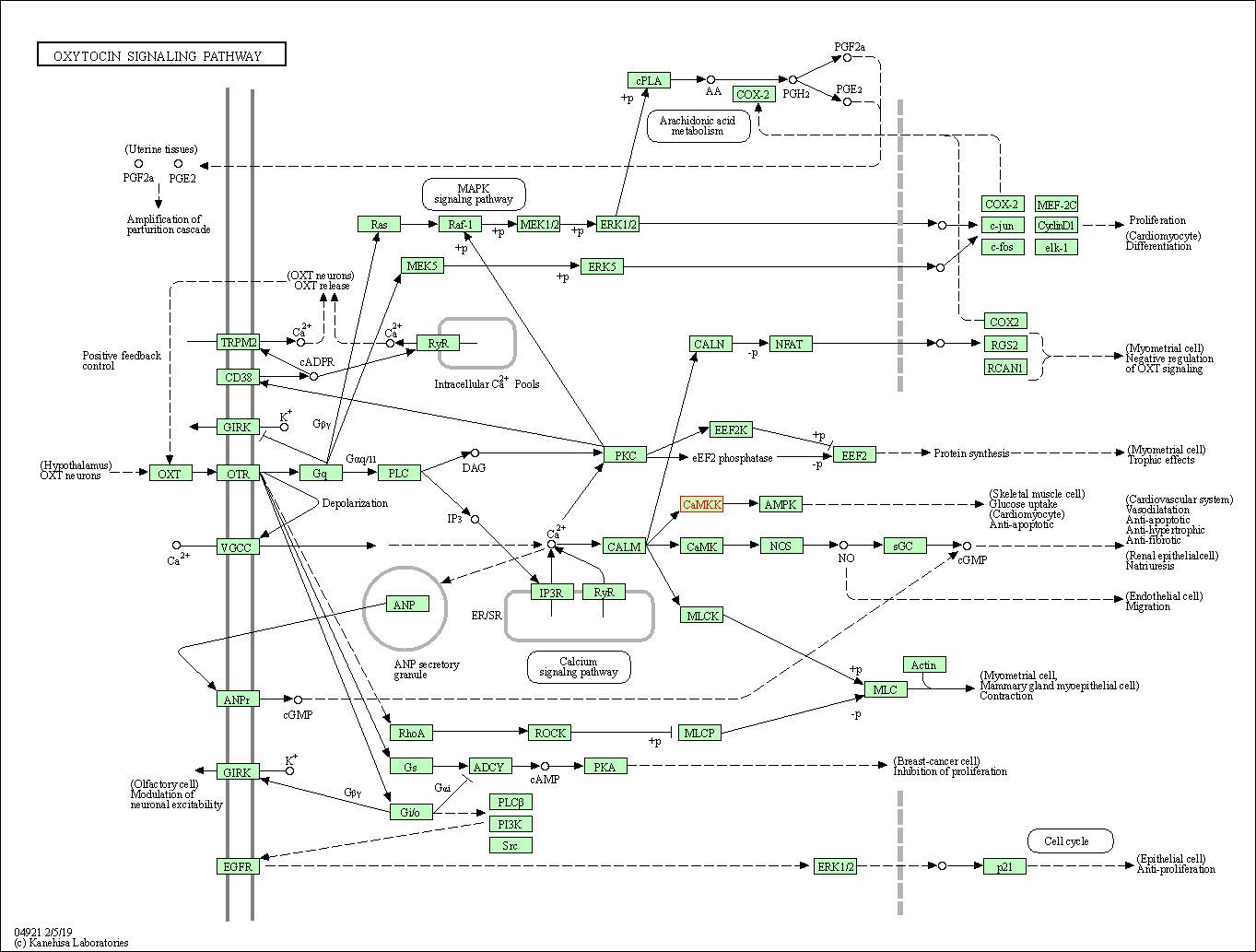
| KEGG Pathway | Pathway ID | Affiliated Target | Pathway Map |
|---|---|---|---|
| Autophagy - animal | hsa04140 | Affiliated Target |

|
| Class: Cellular Processes => Transport and catabolism | Pathway Hierarchy | ||
| AMPK signaling pathway | hsa04152 | Affiliated Target |

|
| Class: Environmental Information Processing => Signal transduction | Pathway Hierarchy | ||
| Longevity regulating pathway | hsa04211 | Affiliated Target |

|
| Class: Organismal Systems => Aging | Pathway Hierarchy | ||
| Adipocytokine signaling pathway | hsa04920 | Affiliated Target |

|
| Class: Organismal Systems => Endocrine system | Pathway Hierarchy | ||
| Oxytocin signaling pathway | hsa04921 | Affiliated Target |

|
| Class: Organismal Systems => Endocrine system | Pathway Hierarchy | ||
| Degree | 8 | Degree centrality | 8.59E-04 | Betweenness centrality | 5.68E-05 |
|---|---|---|---|---|---|
| Closeness centrality | 1.95E-01 | Radiality | 1.33E+01 | Clustering coefficient | 6.43E-01 |
| Neighborhood connectivity | 9.13E+00 | Topological coefficient | 4.50E-01 | Eccentricity | 12 |
| Download | Click to Download the Full PPI Network of This Target | ||||
| Chemical Structure based Activity Landscape of Target | Top |
|---|---|
| Drug Property Profile of Target | Top | |
|---|---|---|
| (1) Molecular Weight (mw) based Drug Clustering | (2) Octanol/Water Partition Coefficient (xlogp) based Drug Clustering | |
|
|
||
| (3) Hydrogen Bond Donor Count (hbonddonor) based Drug Clustering | (4) Hydrogen Bond Acceptor Count (hbondacc) based Drug Clustering | |
|
|
||
| (5) Rotatable Bond Count (rotbonds) based Drug Clustering | (6) Topological Polar Surface Area (polararea) based Drug Clustering | |
|
|
||
| "RO5" indicates the cutoff set by lipinski's rule of five; "D123AB" colored in GREEN denotes the no violation of any cutoff in lipinski's rule of five; "D123AB" colored in PURPLE refers to the violation of only one cutoff in lipinski's rule of five; "D123AB" colored in BLACK represents the violation of more than one cutoffs in lipinski's rule of five | ||
| References | Top | |||||
|---|---|---|---|---|---|---|
| REF 1 | STO-609, a specific inhibitor of the Ca(2+)/calmodulin-dependent protein kinase kinase. J Biol Chem. 2002 May 3;277(18):15813-8. | |||||
| REF 2 | Methods of treating a cancer using substituted pyrrolopyrimidine compounds, compositions thereof. US9623028. | |||||
| REF 3 | 7,8-dichloro-1-oxo-beta-carbolines as a versatile scaffold for the development of potent and selective kinase inhibitors with unusual binding modes. J Med Chem. 2012 Jan 12;55(1):403-13. | |||||
| REF 4 | Protein ligand interaction analysis against new CaMKK2 inhibitors by use of X-ray crystallography and the fragment molecular orbital (FMO) method. J Mol Graph Model. 2020 Sep;99:107599. | |||||
| REF 5 | Crystal Structure of the Human CAMKK2B in complex with Crenolanib | |||||
If You Find Any Error in Data or Bug in Web Service, Please Kindly Report It to Dr. Zhou and Dr. Zhang.

